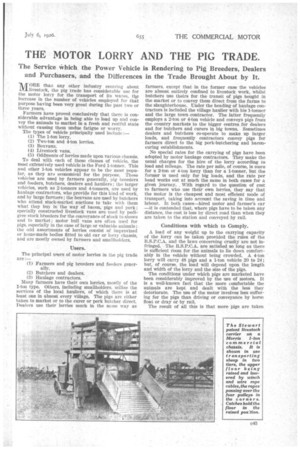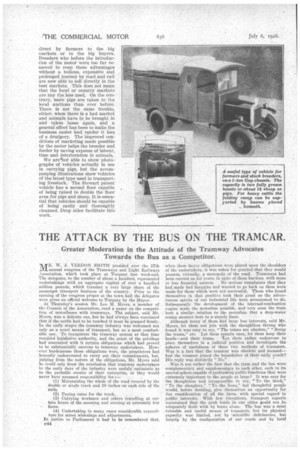THE MOTOR LORRY AND THE PIG TRADE.
Page 33

Page 34

If you've noticed an error in this article please click here to report it so we can fix it.
The Service which the Power Vehicle is Rendering to Pig Breeders, Dealers and Purchasers, and the Differences in the Trade Brought About by It.
MORE than any other industry centring about • livestock, the pig trade has considerable use for the motor lorry for the transport of its wares, the increase in the number of vehicles employed for that purpose having been very great during the past two or three years.
Farmers have proved conclusively that there is considerable advantage in being able to load up and convey the animals to market in a fresh and restful state without causing them undue fatigue or worry. The types of vehicle principally used include :— (1) The 1-ton lorry.
(2) Two-ton and 4-ton lorries.
(3) Boxvans.
(4) Livestock vans.
(5) Oddments of lorries made upon various chassis. To deal with each of these classes of vehicle, the most extensively used vehicle is the Ford 1-tonner. This and other 1-ton vehicles appear to be the most popular, as they are economical for the purpose. These vehicles are used by farmers generally, pig breeders and feeders, butchers, dealers and hauliers; the larger vehicles, such as 2-tonners and 4-tonners, are used by haulage contractors, who provide for this hind of work, and by large farmers; the boxvans are used by butchers who attend stock-market auctions to take with them what they buy in the way of bacon, pigs and pork ; specially constructed livestock vans are used by pedigree stock breeders for the conveyance of stock to shows and to market ; motor bull vans are often used for pigs, especially in the case of large or valuable animals; the odd assortments of lorries consist of improvized or home-made bodies fitted to old car or lorry chassis, and are mostly owned by farmers and smallholders.
The principal users of motor lorries in the pig trade are :— (1) Farmers and pig breeders and feeders generally.
(2) Butchers and dealers.
(3) Haulage contractors.
Many farmers have their own lorries, mostly of the 1-ton type. Others, including smallholders, utilize the services of the local hauliers, of which there is at least one in almost every village. The pigs are either taken to market or to the curer or pork butcher direct. Dealers use their lorries much in the same way as farmers, except that in the former case the vehicles are almost entirely confined to livestock work, whilst butchers use theirs for the transit of pigs bought in the market or to convey them direct from the farms to the slaughterhouse. Under the heading of haulage contractors is included the village haulier with his 1-tonner and the large town contractor. The latter frequently employs a 2-ton or 4-ton vehicle and conveys pigs from the country markets to the bigger centres for dealers and for butchers and curers in big towns. Sometimes dealers and butchers co-operate to make up larger loads, and frequently contractors convey pigs for farmers direct to the big pork-butchering and baconcuring establishments.
No special rates for the carrying of pigs have been adopted by motor haulage contractors. They make the usual charges for the hire of the lorry according to load and mileage. The rate per mile, of course, is more for a 2-ton or 4-ton lorry than for a 1-tonner, but the former is used only for big loads, and the rate per head works out at much the same in both cases for a given journey. With regard to the question of cost to farmers who use their own lorries, they say that the motor is the cheapest and most efficient mode of transport, taking into account the saving in time and labour. In both cases—hired motor and farmer's ear —it is contended that, where pigs have to be taken any distance, the cost is less by direct road than when they are taken to the station and conveyed by rail.
Conditions with which to Comply.
A load of any weight up to the carrying capacity of the lorry can be taken provided the rules of the R.S.P.C.A. and the laws concerning cruelty are not infringed. The R.S.P.C.A. are satisfied so long as there is sufficient room for the animals to lie down comfortably In the vehicle without being crowded. A 4-ton lorry will carry 48 pigs and a 1-ton vehicle 20 to 24; but, of course; the load will depend upon the length and width of the lorry and the size of the pigs.
The conditions under which pigs are marketed have been considerably improved by the use of motors. It is a well-known fact that the more comfortable the animals are kept and dealt with the less they deteriorate. The use of the motor involves less suffering for the pigs than driving or conveyance by horse float or dray or by rail.
The result of all this is that more pigs are taken
direct by farmers to the big markets or to the big buyers. Breeders who before the introduction of the motor were too far removed to reap these advantages without a tedious, expensive and prolonged journey by road and rail are now able to sell directly in the best markets. This does not mean that the local or country markets are any the less used. On the con, trary, more pigs are taken to the local auctions than ever before. There is not the same trouble, either, when there is a bad market and animals have to_be brought in and taken home again, and a general effect has been to make the business easier and render it less of a drudgery. The improved conditions of marketing made possible by the motor helps the breeder and feeder by saving expense of labour, time and deterioration in animals We areonot able to show photographs of vehicles actually in use in carrying pigs, but the accompanying illustrations show vehicles of the latest type used in transporting livestock. The Stewart patent vehicle has a second floor capable of being raised to double the floor area.for pigs and sheep. It is essential that vehicles should be capable of being easily and thoroughly cleansed. Drop sides facilitate this work.
















































